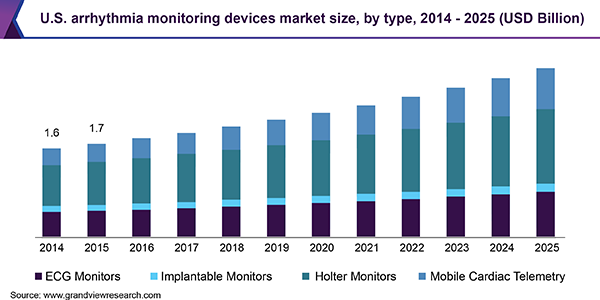Arrhythmias often produce sudden symptoms but typically are no longer present by the time a person gets to the doctor. The patient wears portable ECG devices that record arrhythmic events while the patient is away from the physicians office.
Cardiac Arrhythmia Monitoring Devices Market Forecasts 2026
Cardiac arrhythmia monitoring devices are used for monitoring the patients at risk or with heart arrhythmia.

Arrhythmia monitoring devices. There are four types of cardiac monitoring devices. Ambulatory monitoring devices include. In the report a detailed analysis of the cardiac arrhythmia monitoring devices market is provided.
Ambulatory arrhythmia monitoring devices are used to help doctors to diagnose intermittent cardiac arrhythmia that occurs unpredictably. A symptom event monitor can be either a hand-held device or worn on your wrist. To monitor infrequent arrhythmias the physician uses ambulatory ECG or event recording.
It is projected to expand at a CAGR of 68 during the forecast period. The global arrhythmia monitoring devices market size was valued at USD 498 billion in 2017. The clinical need to monitor outpatients has resulted in advances in technology that now allow us to monitor heart rhythms remotely through a wide variety of devices including ambulatory external monitors implantable event recorders pacemakers and cardioverter-defibrillators.
A range of treatment therapies has been developed for management of cardiac arrhythmia including artificial pacemakers antiarrhythmic drugs and implanted defibrillators. The device can remain in. The most effective way to diagnose an arrhythmia is with an electrical recording of your heart rhythm called an electrocardiogram ECG.
These devices are worn up to 30 days at a time but do not record during that entire period. In many cases the arrhythmia may not occur during this time period leading to the monitoring being repeated. An implantable loop recorder is a small thin device that is inserted under the skin to record the activity of your heart and can be performed as a day case in hospital.
Implantable cardiac monitors ICM are small devices used for long-term monitoring of a patients heart electrical activity to detect irregular heart rhythm arrhythmia. For people with recurrent arrhythmias medical devices such as a pacemaker and implantable cardioverter defibrillator ICD can help by continuously monitoring the hearts electrical system and providing automatic correction when an arrhythmia starts to occur. The cardiac arrhythmia monitoring devices market size valued at USD 55 billion in 2019 and is expected to witness CAGR of more than 68 from 2020 to 2026 led by significant increase in number of cardiovascular diseases along with changing lifestyle.
Cardiac arrhythmia monitoring devices are greatly helpful in following the function of heart and report any variations from the normal in normal functioning such as rhythm. This is the most common recording device as it is usually only used during a 24-72 hour period to detect. The ILR monitors and records your hearts electrical activity in order to identify an irregular heart rhythm.
The back of this device has small metal discs that function as the electrodes. When you feel a symptom or irregular heartbeat you place the monitor on your chest and activate a recording button. The current standard of cardiac monitoring is the Holter monitor which provides 2448 hours of continuous ECG recording.
These devices detect and alarm the heartbeats that are irregular being either too slow or too fast. Many contain smart sensors that can record both heart rate and rhythm. The technology can eliminate the need for a bulky external Holter monitor that requires wire leads attached to the patient and can only monitor the patient for 24 - 48 hours.
If the monitor is worn on a wrist you press the button to record. If the ECG doesnt find a problem you may need further monitoring of your heart. The devices can connect to the internet for data reporting.
Wearable heart rhythm monitoring devices are typically worn on the wrist or on a chest strap. This section covers everything you need to know about these devices. This may involve wearing a small portable ECG recording device for 24 hours or longer.
